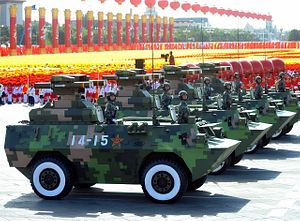While the People’s Liberation Army (PLAN) is still far away from catching up with U.S. military aggregate capabilities, Chinese forces can still pose a formidable challenge to American power in China’s immediate periphery.
That’s the major conclusion of a new 430-page RAND report written by 14 scholars titled “The U.S.-China Military Scorecard: Forces, Geography, and the Evolving Balance of Power, 1996-2017.”
The study notes that China has made progress in most operational areas “with startling speed” while, however, simultaneously emphasizing that “U.S. forces retain some important advantages” in most categories.
In detail, the RAND scholars analyze ten different categories of military capabilities deemed crucial in the event of a Sino-U.S. conflict over Taiwan (closer to Mainland China) or the Spratly Islands (farther from Mainland China), looking at these capabilities during four specific different time periods from 1996 to 2017. The analysis pays particular attention to geography and distance in each scenario.
The military capabilities in each category are summarized on a scorecard that outlines advantages and disadvantages of Chinese and U.S. military forces in both scenarios and across time. Advantage in this context, according to the study, is defined as one side being “able to achieve its primary objectives in an operationally relevant time period while the other side would have trouble in doing so.”
The ten categories (operational areas) include Chinese airbase attack, U.S. versus Chinese air superiority, U.S. airspace penetration, U.S. airspace attack, Chinese anti-surface warfare, U.S. anti-surface warfare, U.S. counterspace, Chinese counterspace, U.S. versus China cyberwar, and nuclear stability.
Overall, the Chinese side fares better the closer a potential conflict is to Mainland China and performs less well over longer geographical distances. For example, in the hypothetical 2017 Spratly Islands campaign scenario, the PLA fails to gain a single advantage over U.S. forces and only reaches approximate parity in four operational areas–Chinese airbase attack, Chinese anti-surface warfare, U.S. counterspace, Chinese counterspace–whereas the U.S. side scores advantages or major advantages in six.
While the PLA gets slightly better marks in a 2017 Taiwan invasion scenario, it still only manages to score a clear advantage in two categories (Chinese airbase attack and Chinese anti-surface warfare) and parity in four (U.S. versus China air superiority, U.S. airspace penetration, U.S. counterspace and Chinese counterspace).
Looking at the ten scorecards, it becomes clear that Beijing still has a long way to go to decisively defeat the U.S. military in a future Sino-US confrontation, particularly since “China’s offensive goals would require it to hold advantages in nearly all operational categories simultaneously” whereas “U.S. defensive goals could be achieved by holding the advantage in only a few areas.” However, the study does note that “China does not need to catch up to challenge the United States on its immediate periphery”.
Should Chinese military modernization continue at current levels over the next few years, the PLA might be able to establish temporary local air and naval superiority, which would enable China to “achieve limited objectives without defeating US forces.” The study also succinctly emphasizes that “China’s ability to project power is improving, and the relative balance in areas more distant from China is also shifting.”

































